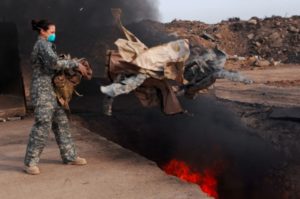
In Balad, Iraq, Senior Airman Frances Gavalis, 332nd Expeditionary Logistics Readiness Squadron equipment manager, tosses unserviceable uniform items into a burn pit in 2008. Adverse effects from burn pits are expected to get more attention from the Biden Administration. Air Force photo by Senior Airman Julianne Showalter
WASHINGTON — Legislators in the past few years have been pushing VA and DoD to work together to better understand the toxic effects of burn pit exposure on servicemembers and for VA to be more lenient in granting disability benefits for conditions that might be related to such exposure.
Despite regular congressional hearings on the issue, progress has been slow. That is expected to change with the arrival of President-elect Joe Biden’s and the incoming Congress.
Biden has talked publicly about how he believes exposure to burn pits contributed to the death of his eldest son, Beau Biden, who deployed with the Delaware Army National Guard to Balad Air Force Base in late 2008. For most of 2009 he served at Balad and at Camp Victory in Baghdad, both of which made extensive use of burn pits to dispose of waste.
In 2013, Beau Biden was diagnosed with Stage 4 glioblastoma multiforme, the most common form of brain cancer. He died 18 months later.
Biden touched on the issue in his 2020 Veterans Day speech, saying, “We have to make sure that no veteran is locked out of treatment for conditions related to toxic exposure.”
He will likely find support on the other side of the aisle from Rep. Mike Bost (R-IL), who has been chosen as the next ranking Republican on the House Veterans Affairs Committee, replacing Rep. Phil Roe (R-TN), who has now retired.
“I am frustrated that we are coming to the end of this Congress without any actionable results on this issue,” Bost said in a House VA Subcommittee on Disability Assistance hearing on the issue last month. “I was hoping that we would consider legislation this Congress that would create a comprehensive presumptive framework for burn pits and other emerging toxic exposures. I’m going to request we schedule a legislative hearing early next Congress to consider various toxic exposure-related legislation. Veterans deserve to have a presumptive system in place that will compensate them for any military-related toxic exposure.”
Legislators have said for years that they did not want the issue of burn pits to go the way of Agent Orange, which took decades to clarify as to presumptive service connections. Both the Senate and House introduced bills late last year that would establish a scientific commission on toxic exposure and create an established timeframe for VA to consider new scientific evidence in the field before making changes to its compensation rules. No action was taken before the end of this latest session of Congress, however.
The goal of veterans’ advocates is for VA to presume certain illnesses to be connected to burn pit exposure for the purposes of providing benefits. Those include multiple types of cancer and a number of respiratory illnesses. However, VA has said that there is not enough scientific evidence to prove such a connection.
Sufficient Evidence?
A report from the National Academies of Sciences (NAS) released in September looked at 27 respiratory illnesses, including respiratory cancers, and found that none met the criteria for “sufficient evidence of an association with service in the Southwest Asia theatre.”
The evidence for respiratory symptoms such as persistent cough, shortness of breath, and wheezing met the criteria for “limited or suggested evidence” for both veterans serving in the 1990-1991 Persian Gulf War and the wars in Iraq and Afghanistan.
However, as in previous reports, the conclusion is not that these conditions are conclusively unrelated to toxic exposure but that better in-theater studies are needed.
VA officials testifying at the subcommittee hearing last month said the agency is still granting disability benefits claims at a high rate among veterans who were exposed to burn pits, even if they don’t consider a clear cause-and-effect link between illness and burn pit.
“For those who say burn pit exposure explicitly in their claim, they have an average of eight considerations and are getting an average of 70% service connection,” explained Beth Murphy, VBA’s executive director of policy and procedures.
VA also defended its approach to emerging toxic exposure science. Patricia Hastings, DO, VA’s chief consultant for post-deployment health services, in answering a question about an NAS recommendation that VA update its mortality analysis for the southwest theatre of operations, said, “We are doing that now. My epidemiology section is very good. Most of the studies that are looked at by the National Academy are done by my office.”
Hastings also said that VA and DoD are working together to integrate research needs into their planning of military operations. “In the future, we will be able to do much closer monitoring and to follow [servicemembers] and veterans. We won’t have to seek information; we’ll already have it.”

